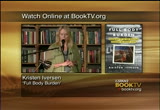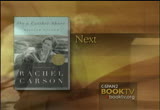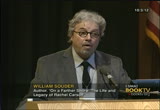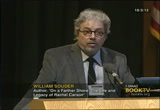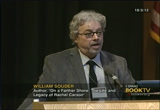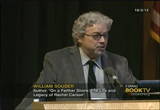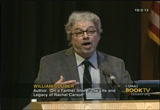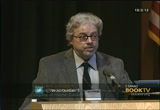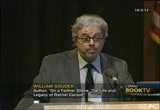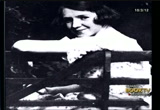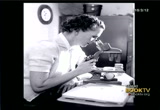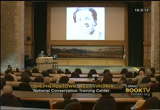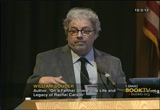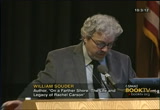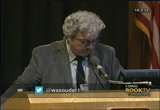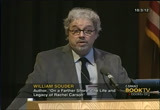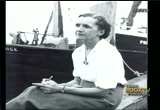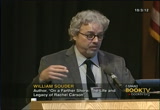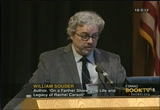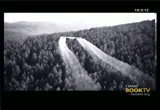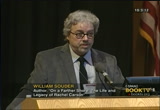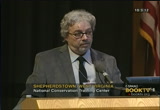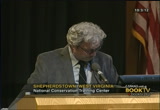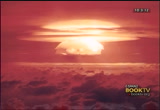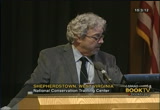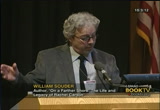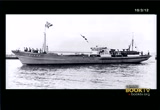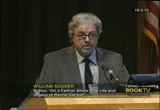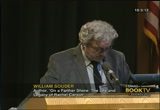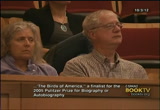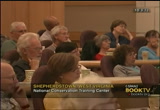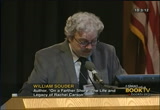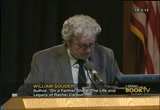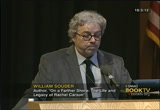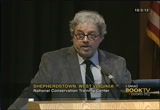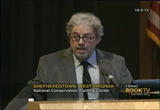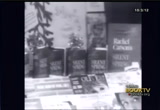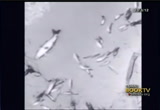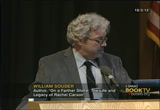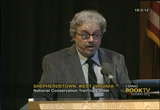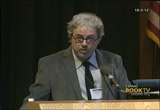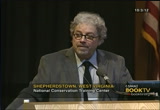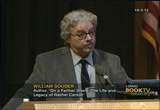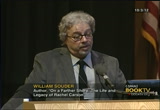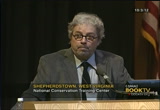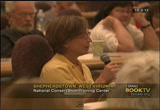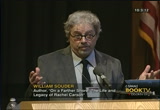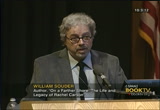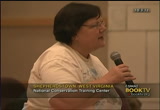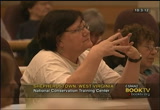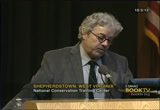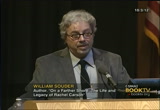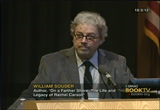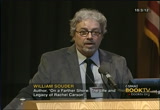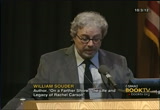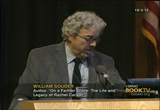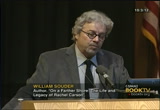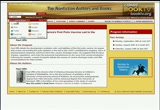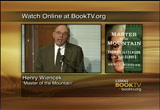tv Book TV CSPAN December 25, 2012 12:30pm-1:45pm EST
12:30 pm
including ddt and are, silent spring published in 1962. following publication coming ddt was banned in protection agency was created. this year marks the 50th anniversary of the publication of "silent spring." this is a little over an hour. hardback >> thank you your thank you offer coming out tonight this wonderful facility. i love coming here.
12:31 pm
it's the coolest place and i wa reminded these guys are so fortunate to work at the national conservation training center. it's a really terrific facility. nice to be back here. nice to see all of you. i guess and the warm-up act for the presidential did a tonight. i promise no spin on a promise to finish intensivists if you can't get enough of politics will deal to go see it, although i don't know who that would be at this point. i'm sure we don't want to see the debate comes so we will finish on time for that. i'm here to talk about rachel carson and bismarck indicated that some of the 27th of december the 50th anniversary of silent spring. she was a famous author before she wrote "silent spring." i'm going to talk more about that tonight. this is rachel and i love this
12:32 pm
photograph. this is the frontispiece of the book. i spent seven months trying to find this photograph and arrange to reproduce it in the book. it was made by irving penn, the great 20th century portrait photographer verboten magazine and actually appeared in "vogue" magazine, although it took me several months to figure out exactly when and where.ccc any event committee was madecc in 1951, so it hasn't been seenc about six decades since the last photograph of rachel carson. by far the best photographs of her ever taken. she would've been 44 years old in this photograph and i just think it's terrific. penn actually shot it this way. it's not cropped. that's the way he photographed. looking around this audience tonight, i suspect most of you know who rachel carson is, but i can tell you generally that is not the case with a lot of
12:33 pm
people. baby boomers and people older than baby researcher amber carson and her work and young people in high school and college are studying rachel carson again in environmental studies classes and they are more likely to know who person was. but in between is a great doughnut hole. i thought that people don't don't know rachel carson, don't know "silent spring" and as a result don't understand origins of the environmental movement and as importantly, the debate and arguments we have around the environmental movement because they have their origins in "silent spring" and reaction to "silent spring" and in the historical context in which person was working. these are questions that interest me a lot. part of the reasoning that a book book about rachel carson is to understand what the movement came from, the role she played in a why we have this partisan,
12:34 pm
divisive, but that argument all the time about iron into manners. it doesn't seem logical. we all live in the state ecosystem. they shouldn't be something we can't agree on and yet we can't agree on it. so carson is the fault line in my view between two important aspects of our relationship with the natural world, to historical movements. the first type is of a conservationist in. this is the idea we should be good shepherds to the earth, we should preserve resources we have, that we should preserve the heritage of wildness the country was premised on for future generations and this is not particularly controversial idea. this wasn't something people disagree quietly about. it's never simple to consider something exciting and somebody's way. but basically this is a nonpartisan concept.
12:35 pm
in 1962, when carson published "silent spring," the conversation shifted. these terms are precise or scientific, but it's still useful constructs for thinking about what changed in 1962. environmentalism is different in several important ways. it's a little more pessimistic, not nearly as forward-looking and are much more immediate, urgent and dyer and with the evolution of environmental thinking, we begin to focus more and more on ourselves come over before the species of concern may be a fish or bird or species of some kind or for his spirit must rethink about the environment and our place an icon of the species of concern became honest. what we were doing to the environment and to ourselves in the process.
12:36 pm
so i think when we look back five decades in the rearview mirror, we can actually see the beginnings of this change in the way we think about the natural world. i call rachel carson a tipping point between these two things. she had a strong presence in the conservation movement and was really an effect founder of the modern environmental movement. i think it's possible to point to a specific movement in time when that happened, when we begin to think about our environment and relationship to the tiered it came in the late summer of 1962 a month before "silent spring" was published. in june 1962 from "the new yorker" magazine published excerpts from "silent spring" and through the course of the summer, huge controversy flared up around the book and people began to take sides, and people began to become worried about what carson was warning everyone
12:37 pm
about. by the end of august, this is in public agenda. i will show you now a video that is good as any other identifiers is tipping point, displacing time for a rethink about environmentalism. [inaudible] [inaudible] >> as president kennedy in august 29, 1962 at the tail end of his news conference. i hope you could hear it very.
12:38 pm
he was asked about pesticides and whether the government would do anything about it. before they got to the question, there's a whole string of questions that turned out to be not unrelated, although it seemed like at the time. several reporters ask about the increase in soviet shipping traffic to the island of cuba and nobody knew what was happening and what that meant, but a couple more months we would know exactly what that was about. i was not in the end i related to a person was talking about in "silent spring." you could also hear the president referred to ms. carson spoke. he said we are going to look into this problem, especially in light of ms. carson's book. what's interesting is 1962, no further introduction was needed. rachel carson, the celebrated author of three books about the ocean, beautiful, lyrical books that were these wonderful transforming experiences for
12:39 pm
readers. carson had only taken science and translating it to beautiful narrative that everybody could relate to and so she'd become one of america's most celebrated a beloved authors in the silent spring turned a very different direction. "silent spring" is a disturbing book, a worrisome book to point that what we were doing to ourselves by the careless use of pesticides in many different places. since it's not 1962 anymore, i thought i would explain more for you about who rachel carson was. she was born in 1907 in the house in springfield, pennsylvania. when a person was born in the upstairs bedroom of the house, at the time did not have the addition on the brick inside.
12:40 pm
very simple, very modest house, four runs. two downstairs and two bedrooms upstairs. there is no central heat, no indoor plumbing. data couple of couple of outhouses out that. a shed in the front of vacation i kept it worse and there was a little bit out of the west.??? there is enough property around the house that carson could explore the woods, often with her mother as a child and she looked birds and animals and was fascinated from a very early age. she was a gifted student and a talented writer even as a young woman. she published several stories before she got out of high school and she earned a scholarship to a small women's college in pittsburgh called pennsylvania for women is now called chatham university. a beautiful campus and a wealthy neighborhood of pittsburgh and
12:41 pm
was quite a step up in the world who came from simple circumstance is to be a college campus. later in life, people describe rachel carson is looking frail and not particularly much of a physical presence. this is her field hockey team. she's the one standing second from the right. she looks pretty firm shot in sturdiness paragraph, but it's probably a bit deceiving. she never came off quite that way later in life. i think her field hockey team or class champions all four years and she was the goalie. this is her senior picture and this is taking she had undergone a significant change. she went off to college plan to major in english and hoping to be a writer. she thought writing was the highest possible calling, something she wants to call herself, something she really loves and wanted to be able to do. but while she was in college she
12:42 pm
became interested in biology thanks in part to an influential professor, but also because carson had discovered she had a genuine and deep. she graduated from pcw, she went to johns hopkins university in baltimore for his zoology and spent her summers at the marine biological laboratory in woods hole, which is right around 1929. person was thinking about getting her doctorate in nuclear zoology or some aspect of biology and she would have had fairly circumscribed opportunities had she done that. the pilot career paths for women coming out of college with phd's in the late 1920s. she could have taught certainly. certainly like the one she just
12:43 pm
graduated from, but the future was in 131 and it was made doubly so for the onset of the great depression, which hit at the exact time carson had first graduated from college. after a couple years at john's heart tends in earning her master's degree doing a little bit of teaching, she really needed to find work. she was kind of the sole breadwinner. her father had mixed success in my her mother lived with carson most of her life in a number of relatives were moving in and out of the household and carson was the one who had a job. in the mid-1930 she went to work for the euro beneficiaries as an information specialist, writing/ press releases and pamphlets an/ radio scripts and doing other kinds of work like it for theoo bureau ofoo fisheries. in 1940, the bureau of fisheries
12:44 pm
with another federal agency as part of president roosevelt's reorganization plan for the federal government and its agencies became the fish and wildlife service, our host tonight. carson spent to balance working for fish and wildlife. mainly as an information specialist. she did have titles along the way. she was an aquatic ideologist and she did do some scientific work for the agency, the most is in the area of communications. she eventually became editor-in-chief, which meant she oversaw the publication,c reviewed lots of technical papers produced by the scientific staff and assertive in charge of the outwardly said the agency to the public. in the mid-1940s, carson had an idea for an ambitious series
12:45 pm
of booklets, pamphlets called conservation inaction. there's seven or eight of these and all and each of them deals with one of the newly established federal wildlife refugees, which needed to be explained to the public. the fish and wildlife service wanted everyone to understand why they're taking the land and setting it aside as refugees and in some places this is controversial. sportsmen are not used to having the government step in and scooped up what they were used to hunting and fishing on. so part of the mission was to explain the rationale for these refugees. one of these booklet was devoted not to a specific refuge, but the subject of conservation generally. the conservation inaction number five was published in 1948. it's really a landmark of
12:46 pm
conservation literature and all of these booklet demonstrated one of the things that scare you sick about carson's work for the government, that it is often too good for the government. several occasions is a dicey taking she written into something else because her supervisors thought the government didn't deserve the literature she was producing. although in fact these were sent out to universities and extension services. you could buy one from the u.s. printing office, but if he went to wildlife refuge and stopped at the information kiosk, you could pick one up and read about the refugee you are visiting. but what you do get a sense of a person was doing. again, this is a pamphlet you get for free if you went to the national wildlife refuge.
12:47 pm
assateague is under the barrier islands typical of the middle atlantic coast. never more than three miles short assurer, length turned she could keep amsc. seen from the gear, the migrated waterfall coming in from the north must have seen it. its eastern borders of white residents in the curbs around the southern end of the island to form a nearly enclosed herbert. back from the beach to say nothing to load games in the hills of sand a little by little ground and restrained at the beach grasses and the locus succulents and loving dune plants. as the vegetation increases commit to a follow into salt marshes or during the day. like islands standing on the marsh areas are firmer, higher ground, carpeted tickets at myrtle, mayberry comes >> , rose. scattered or ponds and puddles
12:48 pm
of vision with bulrushes another good food for ducks and geese. this is waterfall country. this is a country the ducks when the old days before the white man's civilization disturbs the face of the land. this is the country that is rapidly disappearing acceptor is preserved in wildlife sanctuaries. i can assure you most pamphlets turned up any agency or federal government rarely read quite that well. she was really quite remarkable. the one that i've referenced before, conservation inaction number five, the whole theme of american conservations is a fascinating document is basically description of a series of tragedies in the natural world in which resource sector resources overestimated the end of impermanence of locals dare commit things that to numerous to ever disappear were disappearing because the
12:49 pm
overhunting, or harvested or modified or destroyed habitat we changed ecosystems and away the inexhaustible resources. to be completely exhaustible. this was published in 1948 the same year that another american naturalist learned a book you've been working on for several years colloquy possessions is going to be published. he was very excited about this. before it could be published, he was at a shack in wisconsin where he did his writing in a brush fire broke out to his neighbor to help fight inside of a heart attack in the fire. so he never saw his book, but his heirs negotiate with the publisher, which was easier to publish the book after leopold status. he only had one request. they wanted to change the title. they didn't like repossessions.
12:50 pm
they say but you must change it to? they said that they qasim county almanac, one of the pillars of american conservation is some anguished leopold proposed what he called the land ethic, which in simple terms argues it is our responsibility not to look at things that have economic value to us and ecosystems are interrelated and all the species that exist are dependent upon one another in the real application is noneconomic, but moral and a responsibility is to preserve the stability and diversity of ecosystem that when we do things contrary to this entry is. we can't change the natural environment. no one.
12:51 pm
carson moved on. she then read a newspaper and magazine articles all the while that she worked for the federal government and should publish one book in 1941 that had disappeared without a trace. it got good reviews. in 1951 she wrote a book called sea around us, which are agents sent a chapter by chapter to magazine editors hoping someone with publish an excerpt from it. it was seen in "the new yorker" was interested in so carson's agent sending chapters to "the new yorker" all through the summer. persinger frustrated because she was impatient, broke, needed the money and told her agent she wished she could force "the new yorker" to decide which chapter they wanted and publish it because she thought she'd get a thousand dollars if they did and
12:52 pm
that would be a good thing. towards the end of the summer pickup were to carson and her asian was not going to publish the chapter. they were going to publish township tours. the effect that was enormous. before this year by mrs. published as a book, he was destined to be a bestseller, which it did and it turned carson immediately into a household name and as i said earlier, one of the most famous writers in america. the sea around us was number one on "the new york times" bestseller list for 39 straight weeks. it was on the bestsellers list for several years interesting at the time of the top 10, her publisher decided to reissue the earlier book from 1841 called under the sea wind, the one that disappeared without a trace it onto the bestseller lists for a period of time, rachel carson had two of the top 10 books in
12:53 pm
america at the same time on the bestseller list. the sea around us from the national book award, which is in its infancy at the time. the second or third time it has been awarded yet this is a picture at the awards banquet with the other winners that year. on the far left is mary ann moore to run for poetry and in the east james jones for one from here to eternity. i wrote in the book that jones did not particularly happy. they must've been a difficult night for him because everybody knew he was a compromise winner. he was not anybody's first choice. two other novels that cancel each other out. one was mccain mutiny and the other the industrialized was this odd little comic novel about a teenager called the catcher in the rye. so when those two not ted, jones
12:54 pm
was the default winner. at any rate, i love this picture because it's hard to imagine a more unlikely gathering. mary ann morris is skewed here, this high-profile poet who always for the the strike cornered hat. the young were not the list and then rachel carson, zoologist turned nature writer.bhih this is obviously an early high point for carson because she finally achieved her goal of becoming a writer. it's natural to think that she moved from here to mark and a decade later writing about pesticides in "silent spring," but she was already concerned about pesticides at this point because six years before that photograph, she had started to get research being done by the fish and wildlife service on this compound called diabetic
12:55 pm
renal triathlete. ddt. nobody knew what to do with it. it didn't seem to have any practical purpose until a swiss chemist in 1939 discovered that it is a potent insect decide intended to last a long time on services and seemed to be deadly and harmless to other species that were not the target of the poison. i was thought to be effective and safe from the outset and that certainly seems to be the case. palmore won a prize for discovering ddt. production of ddt was ramped up in this country and elsewhere is used extensively throughout the one theaters of operation to combat disease and delousing operations for refugees and people coming out of can terminated areas and they really seem to work.
12:56 pm
in 1943 the u.s. army sprayed ddt in a million civilians in naples, italy and halted a typhus outbreak in the city. through the 1940s in the 1950s and into the early 1960s, ddt goes everywhere and acid jazz, other insect decide chemically similar insecticide that develops another is the whole red pesticides in common use. initially a military setting, but then after the war and forestry, aquaculture, residential. these things are used in hospitals, commercial buildings and lots of different projects. one of the problems are spreading poison from airplanes as it's really hard to control where it goes and yet the system extensively.
12:57 pm
these are all classics. i grew up in florida preservice encephalitis, an epidemic against a brain disease and tracks like this that come through my neighborhood than i did my brothers and i would run out and get his teeth into the murky as we possibly could because it was really fun. i can, it is everywhere, thought to be harmless to people. although i should say that person's interest in ddt was based on evidence that it is not entirely safe. fish and wildlife service has started testing d.c. at a research facility in maryland in 1945. in the very beginning of his clear that tdt is toxic to other species. it didn't just target insects. this toxic to every single species that was tested on and using it in large outdoor settings is a complicated situation, hard to evaluate its
12:58 pm
effects were. animals and birds to disperse, airplanes would drop tdt here in this area over here, so it's difficult to evaluate what its effects were in wide use and is used everywhere and carson understood the data coming out of the fish and wildlife service, the 194800 biologists whose job description was ddt problems and he worked with the fish and wildlife service at the toxin. for the first six pounds came into the united states in 1943. it was tested. we started making it. by 1959 for replying 80 million pounds a year. as i said before, is incorporated in lots of different products, used extensively in forestry and agriculture, but also products you could buy in the grocery store right next to your food. shelf paper for aligning your
12:59 pm
shelves are lined with ddt. then i missed a minor kitchen shows that insecticide laced shelf paper. people with sprayed their beds with ddt. you could buy what is coated on for a small canister you could but in the realm, pull the pin and fumigate around the room and treated in as little as six seconds was the advertising claim. one of my favorites was the device that my dad owned. it is a canister of ddt that screwed onto the muffler of the lawnmower and assume that you want to hide excess costs would fall at and spray out a cloud of insect site across so if you have a company that they, you could poison the area first before they got there. ..
1:00 pm
so got its start in 1939 and was developed during the war and developed into wide use if that is the right word after the war and she thought is of the technology offered a parallel examples that the public could understand and this was one of the important promises of "silent spring," drawing a connection between pesticides and this other technology which was this one.
1:01 pm
[wind blowing] >> that is an animation, that iá not a real explosion. to be able to see it from that á distance it would take eight or es for the sound wave to get to you. if you were far enough away to o see an explosion like that but it illustrates what i am talking about. this is not animation. this is the explosion that occurred on march 1st, 1954, at the king the a tall in the south pacific. this is the first hydrogen bomb. there had actually been one
1:02 pm
hydrogen device exploded a few months before this. was not practical long. was as big as a building and could not be what urbanized but this was a bomb, this was something that could be put on an airplane and dropped somewhere. this was the castle's brothel test. several things went wrong with this test. the fog was any radioactive fallout would be blown ford and arctic, or and populated parts but the wind shifted justthoughe fallout would be blown ford and arctic, or and populated parts but the wind shifted just before they detonated the device and it blew a lot of fallout east of bikini atoll. this was new technology and
1:03 pm
there were lithium isotopes in the fuel for this bomb that were thought to be essentially inert in the explosion or had a low affinity for some of the neutron that would be flying around in the milliseconds of the explosion. i don't even understand the chemistry but the lithium and neutrons better than physicists thought they would and the result was this explosion went off at about 250% of the anticipated yield. with 2.5 times more powerful than anybody expected to be and it was by far already the most powerful explosion that had ever occurred, anywhere on the face of the earth. the guys who pushed the trigger new something was wrong right away. they were in the bunker on the other side of the lagoon 30 miles away from the device and a couple seconds after the touch the trigger and the fire ball went off but before they could hear anything the bunker started
1:04 pm
to move backwards. they realized what was happening was they were feeling the ground shock which travels faster than the speed of sound. no one had ever felt that before because normally the earth and absorbs the ground shock. but this explosion was so big that it actually rocked the bunker 30 miles away and alarmed everybody right away. the third thing that went wrong with this test was it sent thousands of tons of highly irradiated quarrel and pulverized stand up into the stratosphere where a lot of it started blowing along in the jet stream but a fair amount of it fell back to the ocean downwind of the tests and this japanese fishing boat called the lucky dragon on this very unlucky day was fishing about 90 miles away, east of the tests and should
1:05 pm
ended up being coded in fallout coming down like snow, gray ash that fell on every surface and got into every part of the ship. these guys saw the explosion and didn't know what had happened, didn't understand what was coming down on the ship, so a number of them scooped up samples of this stuff to save to put under pillows, some tasted it to see if it was salt because it looked like salt. by the time the lucky dragon got back to japan everybody had radiation poisoning. their skin turned black, their eyes were using, they were frightening to look at. the ship was immediately towed off to the other side of the harbor and kept away from everybody and ultimately burned at sea. the crew spent a year in hospital in tokyo where they had some experience dealing with radiation sickness after the two bombs wheat dropped on japan in
1:06 pm
1945 and eventually they all recovered except for the radium and a guy named kubiyana who seemed well but ultimately died of liver failure. this was a huge international incident and the united states had to pay reparations to the families. they had to pay damages to the fishing industry because to know throughout -- tuna had radioactive burdens for weeks and years after words. this was a serious problem. and one that rachel carson was determined to explore in "silent spring". she really felt what was happening with pesticides was similar to what was happening with fallout from nuclear testing. unexplained for those of you who don't remember we used to blow these things up all time. in total there were about 500
1:07 pm
aboveground atmosphere tests of nuclear weapons between 1945 and 1963 when just about everybody stopped doing it. most of those were by the united states and the soviet union. the united states tested 200 atomic and hydrogen bombs in the atmosphere during that period. in june of 1962 when carson's book was being serialized in the new yorker the united states tested ten nuclear devices, one every three days while "silent spring" was being serialized in the new yorker. i will read a little bit from my book and i will try to identify that for you, this is a little bit about how that connection was made in this book. three long excerpts from "silent spring" ran in consecutive weekly issues of the new yorker beginning on june 16, 1962. although abridged carson's story began in the magazine almost
1:08 pm
word for word as it would in the book. with the short foreboding fable that would be one of the great set pieces in american literature. in it, carson imagine a nameless town in the heart of america where all life seemed to live in harmony with its surroundings. this idyllic place flanked in every direction by lush farm fields and clear running trout streams was home to an abundance of wildlife. foxes and beer and especially birds, an aviary so ridge during migration the spring and fall the people traveled great distances just to see it. so it had been, carson wrote, since the days many years ago when the first settlers raised their houses, spend their wealth and build their barns. then a strange blight invaded the area. it was like an evil spell that brought with its unexplainable sickness and death to livestock. chickens laid eggs that did not hatch. kapor and she turned out did.
1:09 pm
stunted leaders lived only days. the fish in the rivers died and the trout anglers stayed away. people too fell ill. son died leaving the family is grieving and doctors perplexed. roadsides formerly lush with bushes and wild fires were brown and withered and swept by fire. here and very mysterious white power clung to rooftops and lay in the gutters of houses and towns, did the traces of something that had fallen like snow from the skies weeks before. everywhere there was an ominous quiet, a silence that closed the town and surrounding the living world as if the area had become entombed, quote, there was a strange stillness, the birds for example. where had they gone?ñññññí many people spoke of them, puzzled and disturbed. the feeding stations in backyards were deserted. a few birds seen anywhere were moribund. they trembled violently and could not fly.
1:10 pm
it was a spring without voices. on the mornings at once dropped with the dawn chorus of robins, catbirds, and doves, rans and let the bird voices there was now no sound, only silence way over the fields and woods of the march. in the space of ten paragraphs the new yorker combine them into three, carson had written the story of the end of the world. what reader in 1962 could fail to see in this description all bleak possibilities of the modern age? carson's subject was pesticides that she began in a way that just as surely evoked the images of nuclear devastation and all its ensuing sickness and power right down to the residue of poison from the sky. this was a familiar tableau as the cold war had are running preview of such scenes of annihilation and picture many americans already had of the colorless lifeless void that
1:11 pm
resided behind the iron curtain. went oppressive society was understood to be functionally dead but at the same time a deadly threat. in september of 1961 the soviet union had resumed atmospheric testing and by early december detonated 31 nuclear devices including one more than 3,000 times the size of little boy, the bomb that destroyed hiroshima. not a practical on this gargantuan device produced the largest nuclear explosion in history. the united states immediately embark on a crash program to restart it so interesting in the south pacific and did so in april of 1962 just ask carson was finishing "silent spring". the testing continued at a furious pace through the spring into the summer and fall. and the month of june alone as readers were learning of the dark promise of pesticides in the new yorker the united states exploded ten nuclear devices in the atmosphere. that year a nuclear device
1:12 pm
exploded somewhere in the world every few days. so this was the context for "silent spring," this was the parallel that carson drew that would allow the public for the first time to see that the idea of a contaminant, invisible, ubiquitous, not well understood, could enter into the environment on a widespread basis and contaminate the total ecosystem. in early 1963, the television network to a program about "silent spring," interviewed rachel carson and her critics who were legions, she was embroiled in a huge controversy surrounding "silent spring" which had been attacked viciously by the chemicals industry, they were protecting their interests of course, but it was also an argument offered that what carson had proposed an "silent spring" was in some way
1:13 pm
fundamentally an american. what she was asking the country to do was to take a look at an economically important class of products, determine whether they presented a danger to the public and if so, to extend the reach of government into the private sector to regulate them and to do something about it and of course that is not an unfamiliar argument. if you listen to the debate later tonight you will hear the same thing still going on to this day. when president kennedy indicated that the government was going to do something about pesticides he actually meant it. he appointed a presidential commission the day after that press conference that i showed you in the beginning. that commission reported back in the spring of 1963 essentially saying everything carson had claimed in "silent spring" appeared to be true. that pesticides were persistent in the environment, that they were stored in the tissues of
1:14 pm
living things and became amplified to vile accumulation from repeated exposure and also from moving up the food chain as one animal ate another one and had a body burden of ddt and these things became magnified. this appeared to be true. this commission did not have any practical policies to propose immediately to do much about pesticides but it sets the conversation in motion. again, we point to this time frame a year or so, 1962 into 1963 as a real turning point in our discussion of the environment and our relationship to it. i want to show you a little excerpt from that documentary so that you can see and hear rachel carson herself. you will see her at the beginning of this cutback her cottage in maine after she became a well-to-do offer and left government service, she
1:15 pm
built a house in maine on south porche island overlooking the ocean. she loved this location. she loved the marine life in the tide pools at the foot of the cliff she was on and this was her summer destination ever after. it is still there and i lived in it for a week when i was looking on this book and i wrote parts of one of the chapters of my book at rachel carson's desk which was there as it was the day she left. the family of the cottage and have not tried to fix it up. they maintain it but they haven't renovated it still looks the way it did when she was there. let's take a look at rachel carson. >> this is one of the nation's best sellers first chris tidland september 22nd, 1962. up to now 500,000 copies have been sold and "silent spring" has been called the most controversial book of the year.
1:16 pm
biologist rachel carson worked four years in preparation of "silent spring". what she wrote -- >> chemicals are unrecognized partner of radiation in changing the very nature of the world, the very nature of life, since the mid 1940s over 200 basic chemicals have been created using killing insects, weeds, rodents and other organisms described in the modern vernacular, they are sold under several thousand different brands. these aerosols are applied almost universally in ponds, gardens, forests and homes. they have the power to kill every insect good and bad, coat the leaves in a deadly film, linger on in soil.
1:17 pm
all this is the intended target in a few weeks. can anyone believe it is possible to bring down the largest toys and on the surface of the earth without making it unfit for all life. >> i remember scenes like that. the remember seeing fogging trucks coming through the neighborhoods? certainly a different time. rachel carson did not live to see the environmental movement blossomed and flow out of what she started. she was halfway through "silent spring" when she discovered she had breast cancer and it was in advanced stage and not diagnosed well. her treatment was inadequate to halt the disease and so she continued to fight her illness during the second two years, it took four years to write the
1:18 pm
book and she was sick half the time with her cancer and a variety of other illnesseses but she was a strong person and the brave person. i certainly stood up to the people who attacked "silent spring". she was capable of the sending -- defending herself against her critics and did so ably and she was also quite brave and in confronting her illness and the fact that she would not live to see the fruits of her labor. she died in april of 1964 at the age of 56. took six years for something really concrete to happen as a response to "silent spring". there were many things that happened in the ensuing years but the watershed event was when president nixon signed into law -- created the environmental protection agency. one of the first orders of business of the ecb the a was to ban a series of insecticides
1:19 pm
starting with ddt and including all of its cousins, many of which were more toxic than ddt. the domestic ban went into effect in 1972. began phasing them out and it is too bad carson didn't live to see that but she didn't and i like to think of her in this photograph taken by her friends the freeman family who lived next door to her in maine on the shoreline of southport island in 1955, of my favorite photographs of her. she looks very content in this picture and someone who was at home in that environment and at home in the world and at home in her role as an author, scientist and ultimately somebody who would change the way we think about things. that is a good place to stop and take any questions you have. >> anybody have any questions?
1:20 pm
>> why was the book called "silent spring"? >> why was the book called "silent spring"? that probably stems from the opening chapter in which she described a spring in which the birds are absent from the town and carson and her editor and her agent agonized over what to call the book as is often the case. there were a lot of titles they tried out over the course of a couple years when she was finishing the book and finally hit on the idea of -- that first chapter, "silent spring" and her agent suggested that would be a good title for the whole book and that is how it got -- that is how it got its name. >> my question was similar. how did you choose your title? >> again, and i also went through several different ideas
1:21 pm
for titles for this book, it is very difficult sometimes to figure out what to call a book. the first two books i was lucky those titles came to me with almost no thought at all and seemed to fit perfectly and no one objected to them. with this book there were a few ideas i tried out on my editor and other people i was working with on it and it took a long time to find this one but it comes from a poem by t.s. eliot quoted in the beginning of the book and it is a poem that also includes a line about the see around us that rachel carson was fond of. in this poem t.s. elliott describes life as a journey between one shore and another and talks about the importance of stopping to contemplate what happens in between and it seemed to me that was -- i liked the sound of it. for a while i had to convince people and ultimately they gave
1:22 pm
in. >> hold on one second. we will get you a microphone so anybody can hear. >> new yorker magazine -- [inaudible] -- who was her editor there? >> absolutely true. being serialized in the new yorker really transformed carson's life and turned around into the big success that it was. the editor who initially read the manuscript when it came into the front door was the young editorial assistant named edith oliver who went on to be the drama critic of the new yorker for several decades, very famous american critic but at the time she was somebody whose job was to read stuff that arrived unsolicited but she liked it enough that she sent it up to
1:23 pm
the magazine's editor and sean ultimately edited all three of carson's book there were serialized in the new yorker and that included the see around us in 1951, then her third around about the sea called the edge of the sea, in 1955, and then by ao the time carson started work on/ "silent spring" was clear whenever she did was going to bo in the new yorker first so that was all worked out in close consultation with william shawn at the magazine when she started working on that book. she initially didn't want to write "silent spring". even though she was very concerned about pesticides and she thought something should be done she thought somebody else should do it. one of the things that sort of inspired the book was a lawsuit filed in 1958 by a group of landowners on long island in new york who wanted to -- who sued the state of new york to try to
1:24 pm
get and to start spraying ddt over their property and carson thought the new yorkers should write about this lawsuit and it sounded like journalism to her and she tried to convince e.b. white to cover this trial for the new yorker and white who live in maine as cars and did and was concerned about pesticides throwback and said i don't have time to do it but you should. the project was in fits and starts took off from there. >> you mentioned first use of ddt. >> i am sorry? >> up here. the first to use of ddt in the u.s.. where was it manufactured originally? >> it was synthesized and manufacturing bothell, switzerland and samples were distributed to many countries among the allies during the war.
1:25 pm
i don't know who manufactured it during the war, probably it was one of the major chemical companies. after the war there were a dozen or more of the major chemical companies that made ddt and other incentives sides -- insecticides. a long list of prominent american chemical companies manufactured these things. >> thank you. >> my question is about rachel carson support group, people like her seemed to come out of nowhere. she studied and had these interests but i am curious how people like her suddenly appear in a way and i wondered who professionally perhaps besides new york where she was being
1:26 pm
published helps to support her or was she truly just on her own? >> wouldn't it be great if we understood where people like rachel carson come from? they are out there. although she was an overnight success when the new yorker discovered her, she had been riding professionally on and off for 14 or more years by the time the see around us was published in the new yorker including the initial book mentioned that didn't go anywhere at all. she got her start again, by submitting something to her supervisor at the fish and wildlife service that was determined to be too good for government work. he had asked her to write something of a general nature about the ocean. i am not sure what they were going to do but probably put it into the annual report to the bureau of fisheries or distributed in some fashion and
1:27 pm
carson went off for a couple weeks and came back with a long essay about the ocean that really distilled just about everything that was known about oceanography at the time and this lovely poetic narrative and she turned it in and her boss said i am not going to publish the list -- publish this. you should sell the 2 atlantic monthly magazine. carson scented to atlantic monthly and they bought it and published it and a publisher in new york stock the articles, like it very much and contacted carson and encouraged her to write what would become her first book. that is how she was discovered. she had a lot of literary influencess. her first book was patterned on a book by a british writer named henry williamson. his book, called sailor the salmon, was the story of an
1:28 pm
atlantic salmon coming back to its home estuary and ritter and williams and -- carson loved them and she really wanted to emulate henry williamson and her first book was models to some extent on that genre and that approach. she was someone who had a lot of native talent but also paid close attention to other riders and studied other riders and tried to extract what she could from the things that she read and incorporated into her own work. riders are always stealing from other riders and she was certainly consistent with that. >> in the course of your for
1:29 pm
publication soon? >> how are not unpublished materials. they would have been discovered by now. she was one of those rare people who saved everything she ever wrote, and everything that was written to her. in her personal papers which are collected at yale university, everything including her high school teams, per college term papers, all the correspondence between rachel carson and everybody else she wrote letters
1:30 pm
to. i don't think of there is anything undiscovered because we have such a complete written record of carson's life. you always hope you will find something new. ..ñmómófññnño?;=? >> well, he was describing is it his introduction to that my work in the last decade at or so has been mostly about nature and environmeenvironme nt and science and the history of
1:31 pm
nature and the environment and science, and so carson seem like kind of a likely subject to me. i thought about her for a number of years before i got around to working on this biography. i had two primary motivations for writing the book. one was that i felt that it was an unfortunate thing that carson had sort of fallen out of public awareness, a lot of people did not rachel carson was. people would give me a blank look and say who was that again? that just seemed wrong to me. i hope that i could correct that a little bit. the other thing was that i have been curious for a long time about why, as indicated before, why we should have this often ugly argument about environmental matters. why should republicans and democrats think differently about the environment? why should people on the right side of the political place,
1:32 pm
understand the natural world and the way that's different from people on the left. it didn't make sense to me. so i wanted to do with the origins were of that feud, what gave shape to the argument that we have today, and also to see if there were lessons from five decades ago that would inform us all little bit about how we're approaching things today. all those things turned out to be true. rachel carson really did help launch the environmental movement. the reaction related conditions the thinking of the public discourse around environmental matters in a way that persists to this day. if you took silent spring and substituted climate change for pesticide, the arguments would play out in a essentially the same way. people would end up on the same side, the same interests would be largely in place, and we would have the same kind -- we do have the same kind of state we are having 50 years ago. so those things, i was curious about those things.
1:33 pm
i did not set up in the middle of the night and yellow rachel carson, and then spend the next six years doing it. i was curious about all those things. >> [inaudible] -- to the nuclear atomic bomb coming to jihad they opportunity to correspond with other speakers i don't think she talk to very common. i can't remember if there's any correspondence with him in her papers but and i think i would know that if she did. obviously, a lot of overlap there in terms of their mutual concern. but i don't think that she had any contact. that's a good question. i guess in retrospect it's a little surprising that she didn't, i don't recall the. >> given her early concerns about the ocean and all those books that she wrote, and then
1:34 pm
10 years later, you know, silent springs, is there any sign that maybe if she had a little more time she would have become concerned about pollution and the oceans speak with i'm sure she would've been i'm sure, people ask this all the time, what would rachel say today. i'm sure she would be concerned about the depletion of ocean fishing stock and the contamination of the ocean, which is one of those things that seems inexhaustible and infinite when you look at it, which isn't as we know. i believe, i believe there's junk from the economic that's beginning to wash up on the pacific coast this fall. and so, yeah, we know we're doing a lot of bad things to the ocean. i'm quite sure she would be concerned about climate change and probably consider that to be
1:35 pm
the major environmental issue confronting us today. she would be made equally worried about this new resistance to science. anna eshoo it's really new. maybe it's always been with us but it seems more virulent, more widespread right now. we have in our public discussion of environmental matters, and other issues, we often find people simply decided not to believe the facts. and to insist that science is some sort of a hoax or some sort of an imprecise discipline that does not have answers that it claims to have. and his answers are often not preferable to an ideological point of view or political point of view, or some other belief that is inconsistent with a scientific explanation. i think she would find a tremendously frustrating, and wonder if we made any progress
1:36 pm
at all. so it's an interesting thought. wonder what like someone like rachel carson would say and do this day and age. and then the related question, and also always comes up is whether there could be another silent spring. whether there could be another rachel carson in this day and age. i think would be very difficult. one, you have to start with a beloved well-known writers that everybody thinks is great and would never write anything that would distressed some of the slightest way. then that writer needs to somehow run this new media scotland we have in which there is no such thing as an objective neutral craft anymore. there's no such thing, everybody is in these armed camps in the media right now, and we've had, more than a decade now of a really concerted effort to discredit the mainstream media. rachel carson would've been part of the mainstream media, and so
1:37 pm
some of my -- suspect. another voice spouting scientific things that may or may not be true but look like maybe a bad idea for the economy. so the sound so pessimistic, and i'm really not a pessimist at heart but i am, i'm considered unlikely that the circumstances that existed when rachel carson wrote "silent spring" and a loudest of influence it did, are likely to recur anytime soon. >> maybe one last question. >> sure. >> we have some university students in the audience. you didn't get a much of a chance to talk about what was a like for a young woman to pursue science like carson. were there some barriers because of her gender? >> there were barriers. someone, a woman who wanted to get a college education in the
1:38 pm
1920s was in general thought to be pursuing that for her own personal betterment, and not for the purpose of having a career. was to become a better life, a better homemaker, a better mother in the future. that was the object of post secondary education, primarily. women did go into the teaching profession, and so carson certainly could've been a teacher. she could've taught biology, or writing eventually for that matter. that would've been a career avenue that would've been open to a. science was also more open to women than other disciplines were. the marine biological laboratory at, was a place where a lot of prominent women scientists study. one of carson's predecessors was another person who went on to actually become a writer, gertrude stein spent a couple of summers studying marine biology, which i find kind of interesting.
1:39 pm
but yes, carson's prospects would've a very circumscribed by the fact that she was a woman. i was talking order today with someone about her role and whether there was something that was gender oriented about the fact that she was really not given scientific work to do. she was an information specialist. sounded a little bit more like the administrative, clerical side of the operation. i think that probably there's some truth to that. also, she obviously demonstrated through the course of her years that she was more than just somebody who typed up stuff and send it out the door. she was clearly a highly valued employee of the agency, and she did move up. she did a dance. she was given promotions throughout her time working at the fish and wildlife service. she was a professional success at the agency. whether that would've happened had she signed on as an aquatic
1:40 pm
biologist and then tried to do lab work and benchwork as one of the agencies tasked sciences, although less certain the times were definitely different. nowhere in the written record does carson ever complain about this. she never ever uttered a single word about feeling that she wasn't given credit for something because she was a woman, or she was discounted because she was a woman. and actually capitalize on the fact that when the books about the ocean were being published, the critics and reviewers often remarked about how surprising it was that a woman would know about complicated things like oceanography, and a woman had actually gone out on a ship, or put on a helmet and going under the water and look at fish. this was sometimes overstated. she really wasn't a very active or should not differ. she was much better in the library and better communicate with experts that would advisor
1:41 pm
on things. she always allow this perception to stand that she was kind of an intrepid voyager when, in fact, she wasn't. and i kind of like that because she sort of turned the tables on the people to say wow, can you believe a woman, a little woman like that. she used that to her advantage i think. >> bill, thank you very much. let's give him one more round of applause. [applause] >> thank you. thank you all. >> visit booktv.org to watch any of the programs you see here online. type the author or book title in the search bar in upper left side of the page and click search. you can share anything you see on booktv.org easily by clicking share on the upper left side of the page and selecting the format. booktv streams live online for 48 hours every weekend with top nonfiction books and authors. booktv.org. >> what i discovered is that
1:42 pm
jefferson appears to be a man of contradictions, but when you do something rather simple, which is to put them on a timeline and examined all of the same inactions in an actual chronological order, certain patterns emerge, and simultaneously get a little more complicated, but a lot simpler. we are actually dealing with to jefferson. it was the young jefferson was a fiery radical emancipation is, and there was the older jefferson who really embraced slavery. the young jefferson oddly enough is really not been studied all that much. as a newly minted member of the house of burgesses company made a proposal to emancipate slaves in virginia. he made it on slight shielding his identity using a relative to submit a bill, which is a good thing because his relative was announced as an enemy of his country, and the bill was summarily dismissed. but then later under his own
1:43 pm
name as revolution approach, jefferson for a more explicit plan, one that might have changed the course of our history. if only the country would stop the slave trade, jefferson wrote, it could proceed quote to the enfranchisement of the slaves that we have. meaning that they would become citizens, and he wrote this in a document called the summary of, summary view of the rights of british americans which also submitted to the house of burgesses, a committee thereof, and he was again summarily rejected. but that led to his being chosen to write the declaration of independence where he denounced the slave trade in no uncertain terms, another clause that was dropped because south carolina and georgia wouldn't abide any strictures on the slave trade. but after the war, a strange thing began to happen to them. and oddly enough, france is the key to understanding the transformation in jefferson. when you think of france we
1:44 pm
think of sally and james hemmings. we think of french food. jefferson getting to know french architecture and wind. but he went over there on very important national business. he was there as our trade representative. we were desperate for money. we owed a lot of money. the u.s. owed enormous debts to britain, and our most important export was a slave race car. it was tobacco. which brought in some $30 million a year. now, jefferson had one problem. the most important and influential friends yet in court among the french aristocrats were all abolitionists. and they couldn't understand how we fought a war for universal liberty without freeing the slaves. and they put him under tremendous pressure and they kept asking them kept asking him, when is america going to free the slaves? so he began making promises that america, that emancipation was really just around the corner. he was imminent. we
289 Views
IN COLLECTIONS
CSPAN2 Television Archive
Television Archive  Television Archive News Search Service
Television Archive News Search Service 
Uploaded by TV Archive on

 Live Music Archive
Live Music Archive Librivox Free Audio
Librivox Free Audio Metropolitan Museum
Metropolitan Museum Cleveland Museum of Art
Cleveland Museum of Art Internet Arcade
Internet Arcade Console Living Room
Console Living Room Books to Borrow
Books to Borrow Open Library
Open Library TV News
TV News Understanding 9/11
Understanding 9/11